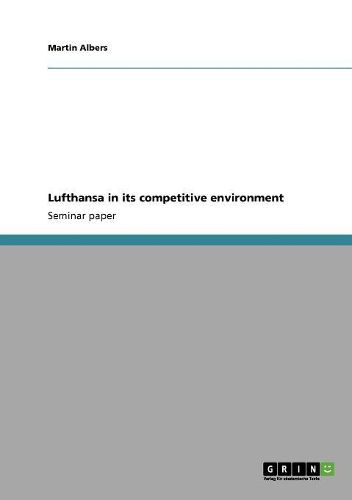Readings Newsletter
Become a Readings Member to make your shopping experience even easier.
Sign in or sign up for free!
You’re not far away from qualifying for FREE standard shipping within Australia
You’ve qualified for FREE standard shipping within Australia
The cart is loading…






Seminar paper from the year 2007 in the subject Business economics - Business Management, Corporate Governance, grade: 2,1, University of Sunderland (University of Sunderland), course: Contemporary Management, 27 entries in the bibliography, language: English, abstract: After five years of vast losses, especially for the IATA Carrier, which are all scheduled airlines, 2007 will be a successful year for the airline industry, with a forecasted profit of $8.5 billion. The early 21st century marked the industry with high losses and consolidation. Due to the reason that the industry sector highly depends on the external environment: the terrorist attacks of September 11th 2001, magnified by the weak economic conditions in many major countries and more recently the Iraq War and SARS epidemic, have made the last five years unhappy ones, especially for most of the schedules airlines. In addition to that, the liberalisation of the European aviation market enabled low cost airlines to reshape the competitive environment and to make significant impacts in the world’s domestic passenger markets, which have previously been largely controlled by full service carriers. The overall market situation is dominated by increasing pressure on cost and productiveness. The global market trend forces a high company concentration that strengthens market positions. Lufthansa - Germany’s national carrier was faced, like all other national carriers with the above-mentioned problems and had to find its way out of the crisis. The central question of this report is: With which tools did Lufthansa solve these problems? And are these tools sufficient to be competitive for future developments? This report paper is dealing with the developments in airline business illustrated with the example of Germany’s national carrier, the Lufthansa AG, and the enormous company restructuring toward an ideal global player in a highly competitive environment. By analysing the internal and external influences, p
$9.00 standard shipping within Australia
FREE standard shipping within Australia for orders over $100.00
Express & International shipping calculated at checkout
Seminar paper from the year 2007 in the subject Business economics - Business Management, Corporate Governance, grade: 2,1, University of Sunderland (University of Sunderland), course: Contemporary Management, 27 entries in the bibliography, language: English, abstract: After five years of vast losses, especially for the IATA Carrier, which are all scheduled airlines, 2007 will be a successful year for the airline industry, with a forecasted profit of $8.5 billion. The early 21st century marked the industry with high losses and consolidation. Due to the reason that the industry sector highly depends on the external environment: the terrorist attacks of September 11th 2001, magnified by the weak economic conditions in many major countries and more recently the Iraq War and SARS epidemic, have made the last five years unhappy ones, especially for most of the schedules airlines. In addition to that, the liberalisation of the European aviation market enabled low cost airlines to reshape the competitive environment and to make significant impacts in the world’s domestic passenger markets, which have previously been largely controlled by full service carriers. The overall market situation is dominated by increasing pressure on cost and productiveness. The global market trend forces a high company concentration that strengthens market positions. Lufthansa - Germany’s national carrier was faced, like all other national carriers with the above-mentioned problems and had to find its way out of the crisis. The central question of this report is: With which tools did Lufthansa solve these problems? And are these tools sufficient to be competitive for future developments? This report paper is dealing with the developments in airline business illustrated with the example of Germany’s national carrier, the Lufthansa AG, and the enormous company restructuring toward an ideal global player in a highly competitive environment. By analysing the internal and external influences, p